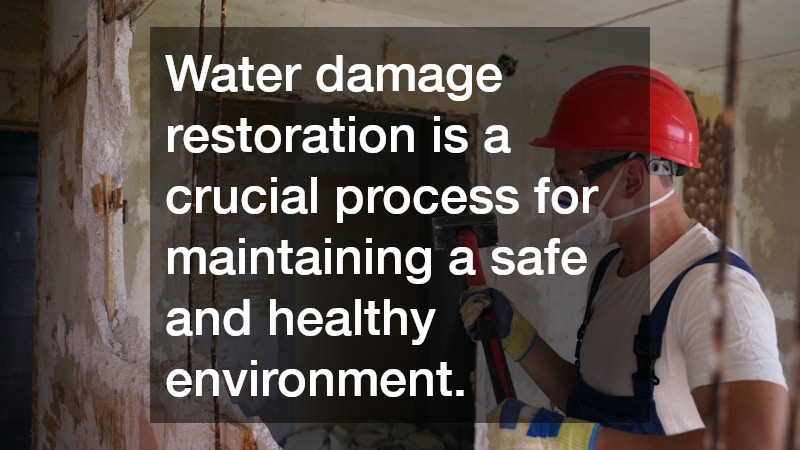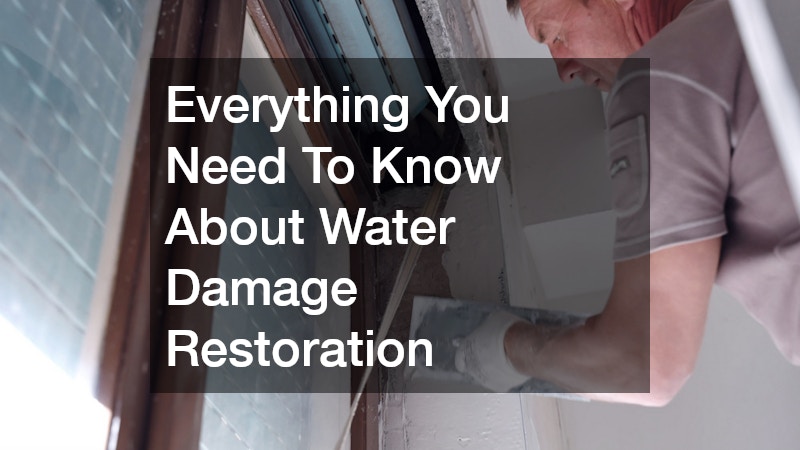Water damage can be a homeowner’s worst nightmare. From severe storms to leaking pipes, water threats can cause substantial damage if not addressed promptly. Understanding the process of water damage restoration can not only save your home but also your sanity.
Understanding Water Damage
Water damage is caused when unwanted water intrudes into a building, damaging materials and systems within. It can result from natural disasters, such as floods, or internal issues like a burst pipe.
Immediate attention is crucial to mitigating long-term effects and ensuring successful water damage repairs.
Without prompt action, water can seep into walls, floors, and furnishings, leading to mold growth and structural deterioration. This kind of damage can be costly, raising liability issues if not properly handled. Understanding the kind of water damage involved is essential to determine the restoration process.
The categorization of water damage into three types—clean, gray, and black water—is important for planning a response. Clean water, though potentially destructive, is less hazardous than gray or black water, which may contain sewage or chemicals. Each type requires a different level of care and expertise in water damage repairs.
The Water Damage Restoration Process
The restoration process begins with an assessment of the damage to determine the extent and type of water involved. This involves detailed inspection using advanced tools to identify affected areas and ensure thorough water damage repairs. Accurate assessment helps in formulating an effective restoration plan.
Once the assessment is complete, the removal of standing water is prioritized. This step is crucial as stagnant water can cause additional harm and is a breeding ground for bacterial contamination. Professionals employ powerful pumps and vacuums to extract the water efficiently.
After the water extraction, the drying and dehumidification process begins. This step uses industrial-grade dehumidifiers and air movers to remove moisture from the environment. Ensuring thorough drying minimizes the risk of mold growth and structural damage.
Restoration and Repairs
Restoration is about more than just drying; it’s about returning your home to its pre-damage state. This phase involves cleaning, sanitizing, repairing, and in severe cases, replacing damaged components of the property. Water damage repairs at this stage focus on restoring functionality and aesthetics.
Carpeting, drywall, and other materials that have been significantly damaged may need replacing. Restoration professionals use specialized equipment and techniques to repair or replace these areas to ensure safety and livability. Special consideration is given to areas that might disguise hidden moisture or mold.
Sanitization is an integral part of the restoration process. This ensures that your living environment is free from contamination that could affect you and your family. Odor removal and sanitation processes adapted for the type of water damage ensure complete mitigation.
Preventing Future Water Damage
Prevention is better than cure, and this rings particularly true with water damage. Regular maintenance of plumbing, roofing, and landscapes can prevent disasters before they begin. Scheduled inspections of these critical areas help in identifying and rectifying potential issues early on.
Installing proper drainage systems and sump pumps is also an effective way to mitigate water damage risks. These systems direct water away from your property’s foundation, preventing it from seeping into your home. Downspouts and gutters should also be checked and cleaned regularly to ensure they function correctly.
Educating yourself about potential water threats and response strategies can also aid in fast action when an incident occurs. Understanding your insurance policy regarding water damage can save valuable time during a crisis. Creating an emergency plan that includes steps and contacts for water damage repairs is advised.
The Importance of Professional Help
While DIY repairs can seem tempting, professional help is often necessary to deal with water damage comprehensively. Certified professionals understand the nuances of water damage restoration and bring essential tools and experience to the task. Their expertise ensures that water damage repairs are performed correctly and efficiently.
Professionals can also help navigate insurance claims, ensuring you receive the compensation needed to cover water damage repairs. They provide documentation and assessments that are crucial for dealing with insurance companies. With professional assistance, the stress of handling paperwork is greatly minimized.
Allowing experts to manage water damage not only guarantees effective repair but also contributes to long-term home health. Without proper repair, unnoticed damp areas could lead to structural problems and health hazards. Trusting professionals allows homeowners to focus on moving forward confidently.
Water damage restoration is a crucial process for maintaining a safe and healthy living environment. From understanding the nuances of water damage to the meticulous restoration process, being informed can help mitigate risks and ensure effective resolutions. Prioritize professional help and preventative measures to safeguard your home from future water-related issues.

